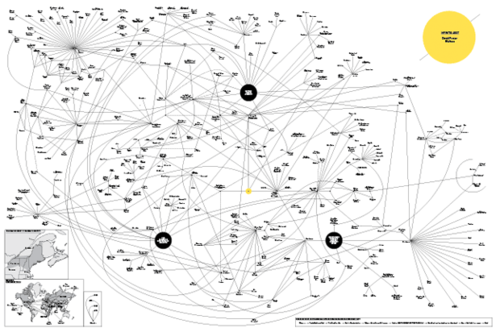The Quantified Self
Yeah. Je kunt alles van en over jezelf bijhouden, volautomatische en funky. Laat je databases vollopen, en gooi er analyses overheen. Je kunt er mee experimenteren, je kunt het gebruiken om jezelf beter te leren kennen, of je kunt je gedrag opnieuw volautomatisch publiceren en verbinden met het gedrag van anderen.
Hoe intrigerend de mogelijkheden ook zijn, ik vind het een doodse of neurotische benadering van het leven (en van reflectie op gedrag). Natuurlijk, self-monitoring is belangrijk als ‘t om medische zaken gaat, en natuurlijk, je kunt veel leren uit data – een groot deel van de vooruitgang in sportprestaties is er aan toe te schrijven. Maar… uiteindelijk zit je met data waar je betekenis uit aan het peuren bent, en de vraag is wanneer dat een methode is waar je werkelijk iets nieuws van leert, en wanneer een methode waarbij je je blind aan het staren bent op data terwijl de weg naar betekenis veel korter is (en de weg naar ervaring ook).
Natuurlijk, je kunt uit andere data leren, en natuurlijk je kunt allerlei funky toepassingen bedenken die gebruikmaken van databestanden. Daar gaat het niet om.
Laat ik het persoonlijk houden: ik vind het helemaal niet interessant of ik nou 62 kilometer heb gefietst of 80 of maar 53,2 en in hoeveel minuten ik dat heb gedaan. Ik vind het ook niet interessant om te weten hoe vaak ik nou precies die ene route neem in plaats van de andere, en hoe zich dat verhoudt tot de routes van anderen. Ik vind het wel leuk om een kaartje te maken van mijn routes, om het plezier van het maken, en vagelijks ook omdat ik weet dat ik op die manier het mij in de toekomst wellicht beter herinner.
Ik vind het ook niet interessant om te weten hoeveel boeken ik heb gelezen in een jaar (of hoeveel bladzijden) of op welke momenten ik heb gelezen, of in een patroon tussen de plekken waar ik lees en de snelheid van het lezen. En hoeveel anderen datzelfde boek hebben gelezen. Ik hou tegenwoordig wel bij wat ik (uit)lees, om het plezier van het maken van die korte stukjes, omdat het schrijven ervan een kort moment is om op de leeservaring te reflecteren, en omdat ik weet dat ik zo een herinnering creëer.
Dingen bijhouden om het bijhouden, en die actie uitbesteden aan de apparaten, is boekhouden om het boekhouden. Je kunt het ook doen om jezelf te trainen – maar dat is een beperkte aanpak.
Ik ben geïnteresseerd in een onmiddellijke omzetting van het ‘boekhouden’ (schrijven) in betekenis – in plaats van via een supersonischsnelle omweg van data-analyse, waarbij de apparaten voor mij de data verzamelen, opslaan, analyseren en mij met hun algoritme-conclusie confronteren.
Deze opmerkingen zijn schetsmatig, nog ongenuanceerd, maar het wordt tijd dat er een goede kritiek op het datamining & quantificerings-paradigma (om het meer even zo te noemen) formuleert. Een kritiek die niet vanuit het verleden komt, of vanuit het verleden redeneert, die niet nostalgisch is, maar die dwars door de technologie en van binnen een hedendaagse perspectief argumenteert.
Wie de ideeën van de ‘quantifiers’ wil horen: bij Mediamatic is maandag een bijeenkomst van The Quantified Self gepland (zie http://quantifiedself.com/) & http://www.mediamatic.net/page/190514/en. De nieuwsbrief viel in mijn mailbox en zette mij aan tot bovenstaand stukje.
Eerlijk zijn nu: wie dacht er allemaal dat de oude Erkki Kurenniemi, tien jaar geleden helemaal de draad kwijt was geraakt – zoals hij werd getoond in Mika Taanila’s The Future Is Not What It Used To Be, terwijl hij alles, werkelijk alles wat hij deed registeerde met zijn digitale cameratje.
